Bleigiessen
A little known jewel of London, 'Bleigiessen' near Euston Station
When you seek out something off the beaten track, one of London’s secrets, here is a place to fascinate – the free museum of the Wellcome Trust. It houses one of London's modern treasures - the Thomas Heatherwick Studios wonderful sculptural creation called 'Bleigiessen'
The Wellcome Collection is designed for those with an over-developed sense of curiosity. It is not a repository of just ghoulish things – though some of the medical instruments and treatments of the past may send shivers down your spine.
It is as interesting place not just for displays from Sir Henry Wellcome’s lifelong collection of over a million artefacts, but for the inspirational marriage of art and science it celebrates.
There are talks, unusual combinations of the arts and medical science – new ways of interacting with complex ideas, complexity made simpler and more understandable by art – a treasure trove of knowledge, made accessible to all.
Check the online programme to see what’s on.
It is in the lofty Atrium at the corner of the Wellcome Trust Building that the stunning 30 metre high Bleigiessen sculpture by Thomas Heatherwick captures London's light and magnifies it in a waterfall of shapes.
Bleigiessen in the Wellcome Trust Building, London
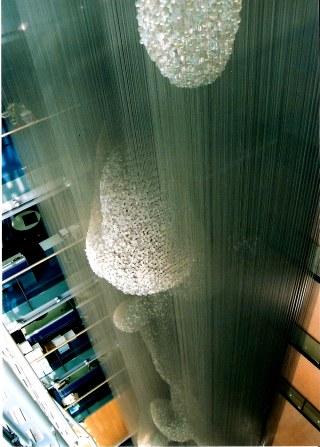
Sir Henry Solomon Wellcome and his college friend Silas Burroughs established the company 'Burroughs Wellcome' that was the first to make and sell medication as tablets and not as liquid.
Sir Henry had a lifelong fascination with the unusual, and his curiosity inspired him to fund extensive research laboratories and to amass over a million artefacts during his lifetime – most on display here.
Responding to the terms of Sir Henry Wellcome’s Will, The Wellcome Trust has become the largest charitable foundation in the world that is dedicated to improvements in human and animal health.
In this context, it is should not seem unusual that the Trust would commission Thomas Heatherwick before he became world renowned purely based upon the richness of his creativity and how he combines art, engineering and civic design, and makes innovative use of materials.
This commission was to create an artwork to fill the atrium area of the newly constructed Wellcome Foundation just down the road from London's Euston Station.
Given that the windows were already in place and the doors small, Heatherwick Studios had a challenge ahead of them to design and install something relevant that would fill the immense space.
Whatever they designed, it would need to be manufactured in small parts that could be internally assembled to fill the towering atrium, and also have some relationship to the pool below.
As Thomas describes it, they decided to work on the principle that whatever media was used, each of the resulting components must be small enough to fit through a letterbox.
The ground floor pool gave the basis of thinking: perhaps the clue was in fluidity.
The studi creatives started to investigate how to fill the space with a form that was, in itself, fluid.
They wanted something that would offer a variable impact in how it looked from many different perspectives:
- from outside
- inside looking down and up, and
- from each of the seven floors.
The idea was to have whatever form they chose to be in itself a discovery – reflective of the spirit of championing and celebrating medical discovery that underlies the Trust itself.
Bleigiessen - molten lead in water
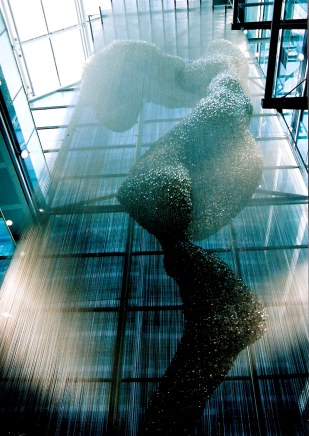
The conclusion was that the design should be fluid in shape, yet somehow be a metaphor that reflected a catalytic reaction between liquid and solid.
Since the space when viewed from the top seemed like a Gravity Chamber, the concept of something falling was taken forward with experiments made by dropping molten metal into water: cold, heated, spinning – creating spontaneously formed shapes.
After over more than 400 tests, the most satisfying shape for the ensuing structure was chosen. The tiny model was then scanned digitally and every detail meticulously recorded in a 3-D diagram.
Every pixel was given an X or Y coordinate, so that during construction the form would be faithfully reproduced.
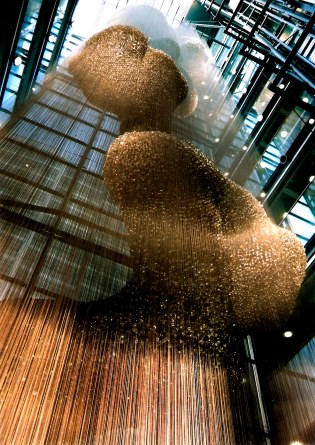
Bleigiessen - a bead curtain
In the past, Thomas Heatherwick’s mother, Stefany Tomalin, owned and operated a bead shop in Portobello Road. The memory of her careful design of bead curtains came to Thomas's mind: he recalled how each bead had a varying effect against light.
This prompted the selection of galss beads as the appropriate medium for creating the design.
The chosen form of the dropped molten metal was accordingly re-created from suspended glass beads.
These were made from specially designed and manufactured glass, so as to reflect light in different ways from different angles, varying the very form and character of the sculpture accordingly.
Thomas Heatherwick’s creative thought called for collaboration from Flux Glass Design Ltd to explore ways of capturing the spectrum within the sculptural form.
The resulting spherical beads were created in halves, like a lens, with a thin layer of specially designed Dichroic Film between the two halves.
As the halves were bonded together, a tiny channel was left for the suspension wire.
Over 145,000 beads were used, their surface slightly rippled in order to magnify their refractory capabilities.
Bleigiessen Dichcroic beads
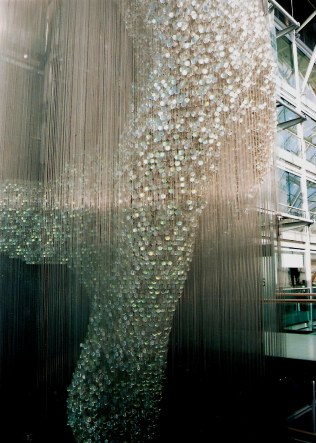
Dichcroic film works like oil on water to give a highly intense version of a basic colour. That used for Beligiessen was donated to the project by the global giant 3M (whose innovation has brought us Sandpaper, Scotch Adhesive Tape, and Post It Notes – among many other things that make life easier or safer).
It seems fitting that this substantial donation to the Bleigiessen project recognised its ingenuity. Over the last 100 years, 3M and their culture has been exceptional in supporting innovation. Their early Director of Manufacturing, Richard Carlton, made the observation:
Some of our products are things you might say
we’ve just stumbled on.
But, you can’t stumble if you’re not in motion.
The chosen colour range for Bleigiessen is nearly a complete colour spectrum that is fully intensified by the Dichcroic film
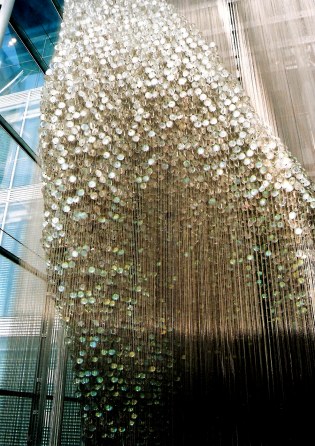
Bleigiessen - refracting light
As you go from floor to floor, the colour spectrum varies according to the quality of light that the lenses filter – to spectacular effect.
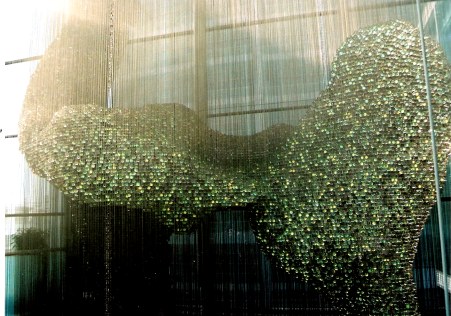
This result is then effectively replicated.
Somehow, the fluid effect of water seems captured within the solid, suspended spheres, each one representing a pixel on the digital diagram of the original metal shape formed by dropping the molten metal into water.
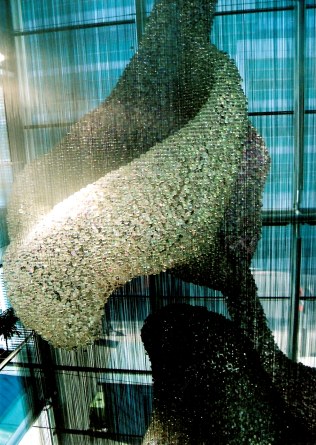
The tradition of lead-dropping
The tradition of Bleigiessen ('Blei' being German for 'Lead') is still practiced at New Year throughout Germany and Eastern Europe today.
This tradition of Lead Dropping has spurred the development of many websites that offer meaning for Bleigiessen forms.
Notably, this old tradition was also celebrated by Thomas Heatherwick’s grandmother. She comes from the beautiful city of Dresden, and helped form Heatherwick’s cultural heritage.
The 27,000 high-tensile steel wires that support the 15 tons of glass beads are in themselves a sculpture.
Here, their lineal geometry complements the changing hues of the glass spheres suspended on them.
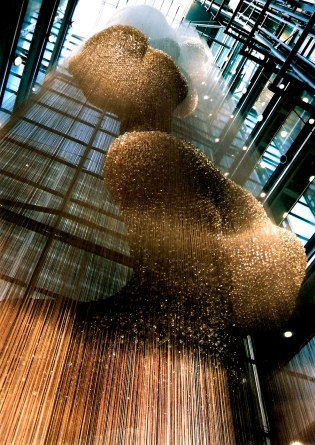
Henri Matisse said that what he dreamed of, was an art of balance.
In Bleigiessen there is an exquisite balance between the wire and the glass balls within what could otherwise have been a very limiting space.
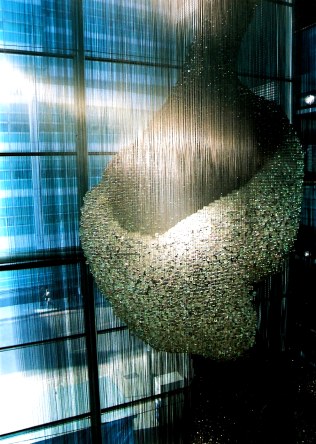
The wires of Beligiessen are seemingly independent of the suspended glass beads, their colour varying with the perspective from which they are viewed.

Waterfall effect of Bleigiessen
The resulting landscape is like water spray from a waterfall - iridescent in the changing light.
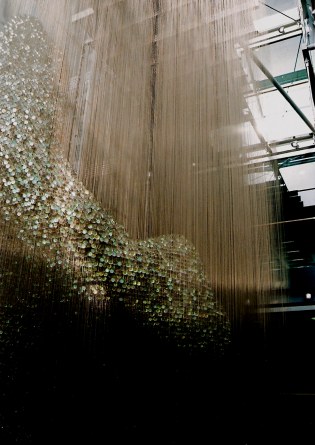
Here, you see another aspect of the waterfall-effect: light and shadow creating rainbow hues that reflect the changing light.
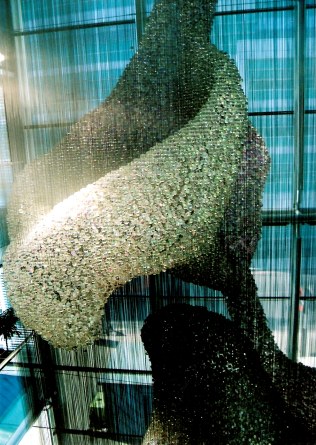
Rainbows are said to have a healing quality – the prism of light cleansing the soul and the spirit.
Bleigiessen generates this response.
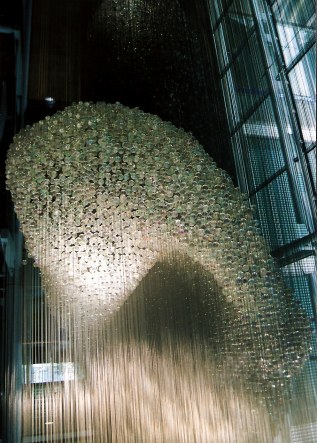
Bleigiessen: suspended imagination
For me, standing at any point where Bleigiessen can be viewed causes me to marvel at something I would call 'suspended imagination'.
You feel the great miracle of art. Here is an art form that can respond to limitations in such a way as to transform the very components used - each becoming an individual thing of beauty.
Bleigiessen assembles great mass so elegantly as to appear light, floating, changing with light and perspective, and captivating the spirit of the viewer.
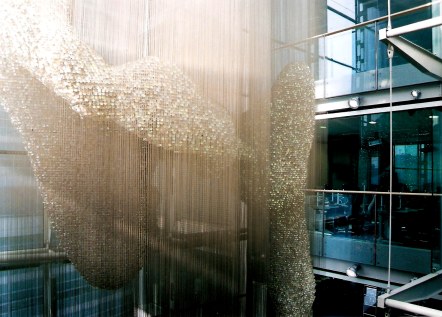
When I look at the base which secures this wonderful creation, it reminds me of a piano.
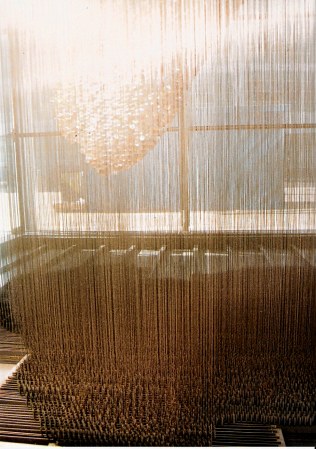
On this piano, there is a never ending, always changing, symphony of suspended imagination.
Working beside Bleigiessen’s suspended animation must surely inspire the person who works at this desk to think more creatively.
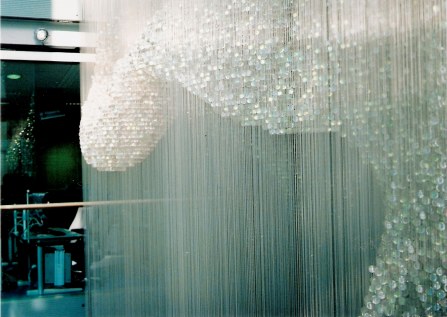
The glass bead game and Bleigiessen
The creative and cross disciplinary thinking that Thomas Heatherwick Studios brings to any project reminds me of Herman Hesse’s enigmatic last work: The Glass Bead Game The Glass Bead Game (Vintage Classics)
In the book, Herman Hesse describes a theoretical game that has since inspired scientists, thinkers, games creators and other mere mortals such as me.
The idea is to find analogies across different areas of interest and be able to state them as universal concepts. As he wrote in the book:
Beginners learned how to establish parallels by means of the Game's symbols, between a piece of classical music and the formula for some law of nature.
As Thomas said himself in discussing how he values the diversity of his Studio’s work:
Because I’m most interested in the gaps between conventional disciplines, the thing I enjoy most is when a new genre offers an opportunity to really define something.
It seems to me the underlying genius of Thomas Heatherwick Studios is that they seem to intuitively play the Glass Bead Game – here almost literally – for Bleigiessen is truly
- cross disciplinary,
- cross cultural,
- beautiful,
- technologically exquisite in the way simplicity results from complexity,
- and inspiring.
Other London Pages






